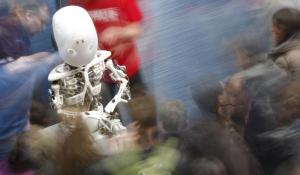Data mining (the analysis step of the "Knowledge Discovery in Databases" process. The overall goal of the data mining process is to extract information from a data set and transform it into an understandable structure for further use.
The actual data mining task is the automatic or semi-automatic analysis of large quantities of data to extract previously unknown, interesting patterns such as groups of data records, unusual records and dependencies.The Knowledge Discovery in Databases (KDD) process is commonly defined with the stages:
(1) Selection
(2) Pre-processing
(3) Transformation
(4) Data Mining
(5) Interpretation/Evaluation.
To know more…….
Data mining involves six common classes of tasks:
Anomaly detection (Outlier/change/deviation detection) – The identification of unusual data records, that might be interesting or data errors that require further investigation.
Association rule learning (Dependency modelling) – Searches for relationships between variables. For example, a supermarket might gather data on customer purchasing habits. Using association rule learning, the supermarket can determine which products are frequently bought together and use this information for marketing purposes. This is sometimes referred to as market basket analysis.
Clustering – is the task of discovering groups and structures in the data that are in some way or another "similar", without using known structures in the data.
Classification – is the task of generalizing known structure to apply to new data. For example, an e-mail program might attempt to classify an e-mail as "legitimate" or as "spam".
Regression – attempts to find a function which models the data with the least error.
Summarization – providing a more compact representation of the data set, including visualization and report generation.
Application Areas….
Games
They are used to store human strategies into databases and based on that new tactics are designed by Computer ( in association with Machine Learning, Artificial Intelligence)
Business
Businesses employing data mining may see a return on investment. In situations where a large number of models need to be maintained, some businesses turn to more automated data mining methodologies.In business, data mining is the analysis of historical business activities, stored as static data in data warehouse databases. The goal is to reveal hidden patterns and trends. Data mining software uses advanced pattern recognition algorithms to sift through large amounts of data to assist in discovering previously unknown strategic business information. Examples of what businesses use data mining for include performing market analysis to identify new product bundles, finding the root cause of manufacturing problems, to prevent customer attrition and acquire new customers, cross-selling to existing customers, and profiling customers with more accuracy.
Science and engineering
In recent years, data mining has been used widely in the areas of science and engineering, such as bioinformatics, genetics, medicine, education and electrical power engineering.
Human rights
Data mining of government records – especially records of the justice system (i.e., courts, prisons) – empowers the revelation of systemic human rights infringement in association with era and publication of invalid or deceitful lawful records by different government organizations
Medical data mining
Some machine learning algorithms can be applied in medical field as second-opinion diagnostic tools and as tools for the knowledge extraction phase in the process of knowledge discovery in databases.
Spatial data mining
Spatial data mining is the application of data mining methods to spatial data. The end objective of spatial data mining is to find patterns in data with respect to geography. So far, data mining and Geographic Information Systems (GIS) have existed as two separate technologies, each with its own methods, traditions, and approaches to visualization and data analysis. Data mining offers great potential benefits for GIS-based applied decision-making.
Temporal data mining
Data may contain attributes generated and recorded at different times. In this case finding meaningful relationships in the data may require considering the temporal order of the attributes.
Sensor data mining
By measuring the spatial correlation between data sampled by different sensors, a wide class of specialized algorithms can be developed to develop more efficient spatial data mining algorithms.
Visual data mining
During the time spent transforming from analogical into computerized, vast datasets have been created, gathered, and stored finding measurable patterns, trends and information which is covered up in real data, with a specific end goal to manufacture prescient formations(patterns).







